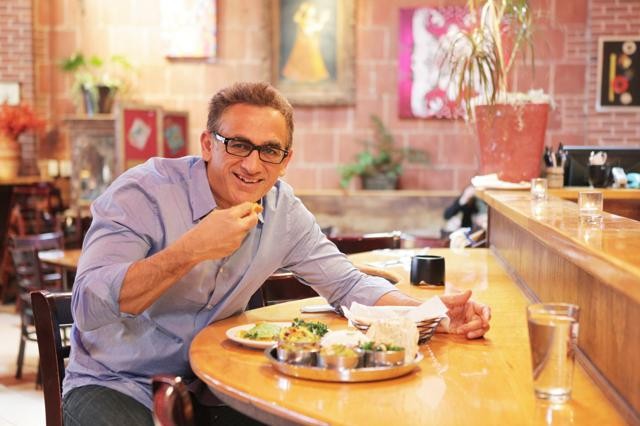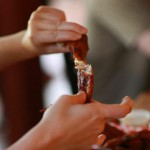- FORK-FREE: According to Anoop Krishnan, owner of Mela Indian Restaurant, the Indian tradition of eating without utensils reflects reverence for the food and offers a unique sensory experience. Photo by Jayson Im
- FINGER LICKIN’ GOOD: The menu at Rocky’s Hot Chicken Shack provides plenty of opportunities for hands-on dining. Photo by Toby Maurer
Have you ever caught yourself at a restaurant holding a piece of chicken with your fingers and wondered: Is anyone looking?
“Emily Post said it’s correct etiquette to eat fried chicken with your hands,” says Chef Bob Wallace of Rocky’s Hot Chicken Shack. (His grandmother, he says, always quoted Emily Post.)
Rocky’s co-owner Lauren Cundiff agrees. “Chicken is in that category of food meant to be torn off the bone and put in the mouth and have a moment with it,” she says. Before she and her husband, Rich, opened Rocky’s, they researched several chicken joints in Tennessee. “People were pulling the chicken apart with their hands,” Cundiff recalls. “There were no utensils involved.”
Wallace takes it a step further: “It could be considered pretentious or pompous to eat a chicken leg with a knife and fork.” It’s also a bit unwieldy.
Bryan King, co-owner of 12 Bones Smokehouse says, “Some foods are too tricky to eat with a knife and fork. … With ribs you want to dig in and get it all over you.”
“We always use our hands,” Anoop Krishnan, owner of Mela Indian Restaurant, says of the Indian food culture, “but there’s a certain etiquette: We only use our right hand, specifically the thumb, pointing finger and middle finger.” In India, this traditional way of eating is still practiced today. Krishnan feels it is a more reverent way of eating. “You want to respect the animals you are eating, not poke them with a fork,” he says.
“Eating with your hands brings us back to childhood, and it’s very primal,” says King. “We’ve been eating like that for thousands of years. It’s a much more intimate experience.”
Cultural differences
Although barbecue is typically associated with Southern cuisine, it crosses cultural lines. “My wife, Angela, is of Korean heritage and grew up eating Korean barbecue,” King says. He reveals that 12 Bones has experimented with Korean barbecue flavors with its rib sauce, but shies away from getting too fancy. “At the end of the day, we’re a barbecue place.”
Krishnan points out there are fewer disruptive sounds when eating with one’s hands — no clinking of utensils against plates. “It’s a different sensory experience,” he says. “It begins before you eat, when you first feel the food in your fingers.”
“The draw of eating with your hands is the simplicity of it,” says Dustin Pulliam, owner of the Twisted Crepe. “It’s easier than cutting stuff up.” The Twisted Crepe puts an American spin on the French crepe; folded, the triangular-shaped wraps come in savory and sweet varieties, made fresh on the spot. “It’s kind of like eating a pita pocket,” Pulliam says. “I wanted customers to have the ability to eat while they walk downtown.”
Krishnan’s parents emigrated from Northern India to Malaysia, where he was born and raised in a large Indian community. When Krishnan’s father visited Asheville, he decided to experiment with utensils. “My father held his knife like he was going to stab something and said, ‘Now what?’” Krishnan explained he should cut his food into small pieces, then put the knife down and use his fork. Frustrated, his father shook his head, claiming it was unnatural and asking why it had to be so complicated. “People were laughing,” Krishnan recalls.
A thali is an Indian meal made up of several dishes served in small bowls called katori and placed on a round tray with raised edges. Traditional Indian meals can also be served on a banana leaf. “Typically, you tear off a little piece of naan (Indian flat bread) and use it as a scoop, or you mix the dishes with rice to form a little ball,” Krishnan explains. According to Krishnan, because of the tradition of eating with one’s hands, you seldom see Indian men and women with long fingernails; the nails are traditionally kept short and manicured, and the hands scrubbed clean.
Hands-on fun
For the full hands-on experience at Rocky’s, Wallace recommends the mac-and-cheese poppers: homemade macaroni and cheese made with five cheeses, rolled up, breaded in a buttermilk and flour mix, then deep-fried. Customers love to dip them in spicy ranch dressing, he says. If you prefer a healthier alternative, carrot and celery sticks (typically served with chicken wings) can always be ordered as a side. “They’re great to refresh the palate,” says Wallace.
Of course, diners at Mela Indian Restaurant always have the option of using utensils, but your next visit could be a great opportunity to experiment with traditional Indian methods. “When Oprah visited India, she offended many people by saying we were still eating with our hands, implying we hadn’t developed into the modern world,” Krishnan says. “But for us it is not backward; it is our choice because we feel it’s the better way. We wonder why anyone is still eating with forks and knives.”
Mela Indian Restaurant, 70 N. Lexington Ave., 225-8880 or melaasheville.com; Rocky’s Hot Chicken Shack, 455 Patton Ave., 575-2260 or rockyshotchickenshack.com; 12 Bones Smokehouse, 5 Riverside Drive, 253-4499 or 12bones.com; Twisted Crepe, 62 Haywood St., 505-3855 or twistedcrepe.com.






Before you comment
The comments section is here to provide a platform for civil dialogue on the issues we face together as a local community. Xpress is committed to offering this platform for all voices, but when the tone of the discussion gets nasty or strays off topic, we believe many people choose not to participate. Xpress editors are determined to moderate comments to ensure a constructive interchange is maintained. All comments judged not to be in keeping with the spirit of civil discourse will be removed and repeat violators will be banned. See here for our terms of service. Thank you for being part of this effort to promote respectful discussion.